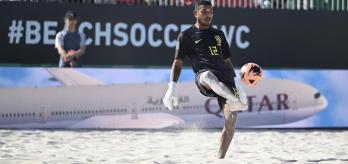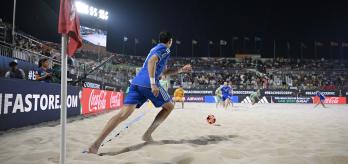The significant differences in their ideas highlight the fact there is no “right” way to press; the best pressing strategy is the one that best suits the strengths of the players available.
The statistics provide ample evidence of the effectiveness of a variety of strategies. For instance, Brazil spent 83% of their out-of-possession time in high press/high block, and executed far more high presses (68) than any other team in the competition. UAE ranked second with 40, and Belarus were third with 38. By contrast, Italy recorded only 25 high presses, and they were all individual high press (i.e., a press initiated by one player). They never used an organised high press (a co-ordinated press involving the entire team on the pitch) at any point in the tournament. However, Italy did execute significantly more low blocks (243) than any other team. Belarus ranked second 184 and Portugal third with 182. Brazil moved into a low block just 147 times, showing this was not their preferred defensive option.
In the clips below, the members of the Technical Study Group highlight some of the ways teams pressed when in the defensive phase.
Pressing the 1-2-2
When playing against a 1-2-2 formation, teams have a number of different options to execute an effective press. Here, Matteo Marrucci explains the “classic” rotations that are often used to counter teams operating in this attacking formation.
The classic rotation in a 1-2-2 defensive phase
In clip 1 below, we see Colombia operating in a normal 1-2-2 attacking set-up against Belarus. First of all, Belarus apply pressure to the goalkeeper, which leaves Colombia’s wide left outfield player free. At this point, the Belarussians rotate their defence; Ihar Bryshtsel (8) comes to press the wide player in possession and all the other Belarus players follow up by rotating to the next player. This is a textbook defensive rotation, with the trigger to rotate coming from the initial pressure applied on the goalkeeper and his pass to the player on the Colombian left flank. The rotation is perfectly timed and Bryshtsel’s press leads to him winning the ball back and scoring.
“In the second clip we see another variation of this rotation in Senegal’s press against Belarus (who are playing in a 1-2-2). Following an initial rotation, Senegal maintain 2v2 and have their two highest players rotate, so they are pressing Belarus’ 1-2-2 in a 1-2-1-1 defensive phase. We can see how the front two players press the wide Belarus players alternately, then realigning centrally when the ball goes back to the goalkeeper. This is a good example of the other traditional way of pressing against a 1-2-2.
Pressing against the 1-2-1-1
In the next video, we see how Italy’s defensive rotation against Brazil’s 1-2-1-1 only involved three outfield players, with their last player staying man-to-man against the highest attacker. As Brazil develop their attacking play, Italy defender Luca Bertacca (6) man-marks his assigned opponent, and does not participate in the defensive rotation.
Getting aggressive
Pressing can either be passive or aggressive. Passive pressing is intended to force the player in possession to change direction or take another route to goal, whereas aggressive pressing is designed to win the ball back or prevent the opposition from moving forward.
Pressing the goalkeeper
When pressing aggressively, particularly man-to-man, teams also need to find ways of pressing the opposition goalkeeper. With goalkeepers becoming more involved and influential in their team’s attacking play, leaving them with time and space is not an option for a successful beach soccer side. If they opt to press the goalkeeper, defending teams must time their defensive rotations precisely. When they are numerically overloaded by the opposition, the defenders need to occupy the spaces between attacking players, so that they have time to get into position and press if one of the players they are covering receives the ball. In these circumstances, defending players must constantly be aware of their covering and balancing roles in the team’s defensive effort.
As Marrucci explains, clip 4, which is taken from the encounter between Colombia and Japan, is an excellent of how to press the goalkeeper effectively:
“As soon as the left-sided Colombia player leaves his player to press the goalkeeper, he stays on the goalkeeper, while the right-sided player presses the player near the touchline receiving the ball,” Marrucci notes. “When this happens the two deepest players respond, the left-sided defender advances towards the player left free by the left winger (who is pressing the goalkeeper) and the one remaining defender splits between the two opposition forwards in the final third. By doing this, we see that Colombia can exert aggressive pressure on the ball, everywhere it goes.”
In the last clip, we see a great example of an aggressive press during Brazil’s game against Oman, with cover and support provided by their deeper players. As soon as the goalkeeper is pressed by left winger Datinha (10), right-sided forward Edson Hulk (7) locks on aggressively as the ball travels to Oman left-sided defender. While the front two exert this direct pressure, the left-sided Brazil defender advances to get pressure on Oman’s spare player. When Brazil win the ball high up the pitch, their players are closer to the opposition goal.”
Summary
The final of the FIFA Beach Soccer World Cup 2024 was an object demonstration of the fact that there is no one “right” way to press the opposition. Brazil and Italy had very different pressing styles, but both of them proved highly effective. The method you choose will depend on the strengths and weaknesses of the players available to you, but it is always key for every player to know their role instinctively. A successful press, whether individually or collectively, also requires quick thinking; the first step towards disrupting an opposition attack is being able to spot how the move is developing. Most importantly of all, a good beach soccer team has to defend as a unit from front to back and be clear in roles and responsibilities. With the increase in attacking threats posed by opposition goalkeepers, defensive structures and rotations must use all five defending players with strategies to affect all five opposition players.



















